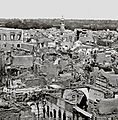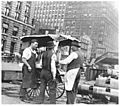Syrian American facts for kids
| Total population | |
|---|---|
| 154,560 | |
| Regions with significant populations | |
| New York, Massachusetts, Michigan, Louisiana, Ohio, Iowa, Texas | |
| Languages | |
| American English, Arabic (variants of Syrian Arabic), Kurdish, Armenian, French | |
| Religion | |
| Christianity (mostly Eastern Orthodox and Eastern Catholic), Islam (mostly Sunni), Judaism | |
| Related ethnic groups | |
| Other Syrian people, Lebanese Americans, Iraqi Americans, Armenian Americans, Assyrian Americans |
Syrian Americans are people living in the United States who have family roots in Syria. This group includes both people who were born in Syria and moved to the U.S., and also the children and grandchildren of Syrian immigrants. Many Syrians first came to the United States around 1880.
Early Syrian Americans often settled in big cities like New York, Boston, and Detroit. For a long time, it was hard for Syrians to move to the U.S. because of a law called the Immigration Act of 1924. This law made it very difficult for people from many countries to immigrate.
However, things changed more than 40 years later. The Immigration Act of 1965 removed these strict limits. After this, many more Syrians came to the United States. It's thought that about 64,600 Syrians moved to the U.S. between 1961 and 2000.
Most Syrian immigrants who came between 1880 and 1960 were Christian. A small number were Jewish. Most Muslim Syrians arrived in the United States after 1965. In 2000, there were about 142,897 Americans who said they had Syrian family roots.
Contents
Syrian American History
People believe that the first Syrian immigrants arrived in the United States in the 1880s. They came from a region then known as Greater Syria. This area included what are now the countries of Lebanon, Jordan, Palestine, and Syria itself.
These early immigrants often worked as peddlers. They sold things like linen door-to-door. Many immigrants from this region were called "Syrian," even if they were not ethnically Syrian. This makes it tricky to know the exact number of Syrians who came in the early years.
Most early Syrian immigrants were Christian. They came from villages around Mount Lebanon. A historian named Philip Hitti estimated that about 90,000 "Syrians" arrived in the U.S. between 1899 and 1919. Many settled in the northeastern United States. Key cities included New York City, Boston, Detroit, and the Paterson, New Jersey area.
According to the 2000 United States Census, there were 142,897 Americans with Syrian ancestry. New York City has the largest group of Syrian Americans. Other cities with many Syrian Americans include Boston, Dearborn, New Orleans, Toledo, Cedar Rapids, and Houston. Large Syrian populations are also found in Southern California (like Los Angeles and San Diego) and Arizona.
How Syrian Americans Blended In
Early Immigrants (Before 1965)
When the first Syrian immigrants arrived, they wore traditional clothes. They also worked as peddlers, which was different for many Americans. This sometimes led to people being unfriendly towards them. Some U.S. officials even said Syrians couldn't become citizens because they were from Asia.
However, Syrians quickly worked to fit into their new country. They changed their names to sound more American. They learned to speak English and joined common Christian churches.
Syrians did not stay only in their own communities. Many peddlers met Americans every day. This helped them learn the language and customs of the U.S. Serving in the military during World War I and World War II also helped them blend in. Early Syrian immigrants became so Americanized that it can be hard to trace their family roots today.
Later Immigrants (After 1965)
After 1965, most Syrian immigrants were Muslim. They sometimes found it a bit harder to blend in. This was partly because of their Islamic faith. Also, in the 1960s and 1970s, there was a trend in America where people were less interested in everyone becoming exactly the same.
These newer immigrants often felt proud of their Arab identity. This was helped by the growing idea of multiculturalism in the U.S. This idea encourages people to respect different cultures and traditions, including Islamic customs.
Language Spoken by Syrian Americans
Most Syrians speak Arabic. While some might speak formal literary Arabic, many speak Syrian Arabic. This is a specific way of speaking Arabic that belongs to the Levantine Arabic family of dialects.
There are even different accents within Syrian Arabic. For example, people from Aleppo sound different from those from Homs. Syrians can usually understand most other Arabic speakers, especially those who speak Levantine Arabic.
Many older Syrian American families no longer speak Arabic. This is because parents often didn't teach it to their children. However, newer immigrants usually keep their language traditions alive. The 2000 census showed that nearly 80% of Syrian Americans spoke English "very well."
Across the United States, some schools offer Arabic language classes. Also, some Eastern Orthodox churches hold services in Arabic. It's also worth noting that Syria and Lebanon were under French rule for a short time. Because of this, many Syrian Americans also know some French.
Images for kids
-
Paterson, New Jersey, especially its Little Ramallah neighborhood, is an increasingly popular destination for Syrians and home to the second largest Syrian American population, after New York City.
-
Syrian man selling cold drinks in Lower Manhattan, circa 1908
-
Syrian peddlers in Lower Manhattan
-
A garnished dish of tabbouleh
-
35% of Syrians 25 years and older have a Bachelor's degree or more, compared to 24.4% of all Americans










